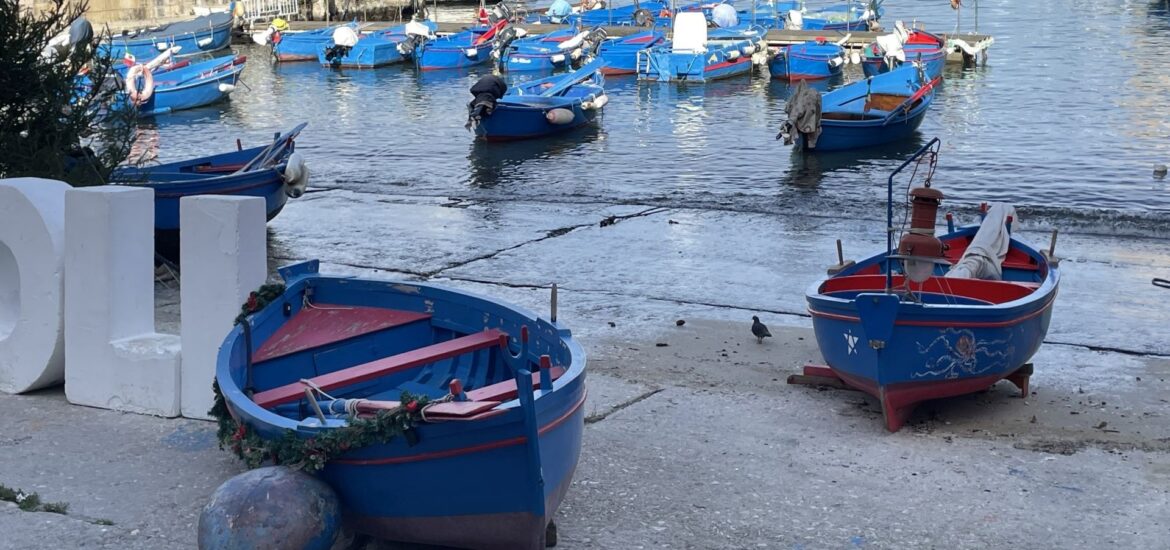I‘ve got so many fond memories of beautiful places in Puglia (Apulia) that it is hard to make a choice, but I think it would be nice to describe my visits to Monopoli, Taranto and Polignano a Mare. Three totally different places, each with its own charm and characteristics.
What should I tell you about my experiences? I’ll give you a few examples: I discovered an old Fiat 500 in a narrow alleyway of Taranto and I shuddered when visiting the Church of the Purgatory in Monopoli with its mummies and gruesome decorations. And I will never forget the mystic atmosphere in Polignano a Mare that was created by the morning fog, wrapping this old town perched on a high cliff.

MONOPOLI
Monopoli is an amazing coastal town that blends history, culture and natural beauty. The area has been inhabited since prehistoric times and the blend of influences from Greek, Roman, Byzantine and later cultures has created a unique heritage and a fascinating destination for people interested in Puglia’s rich past.
The weather was sunny when we arrived in Monopoli, but the sea was rough and many people were watching the high waves along the promenade. We parked our car on the ‘Lungomare’ and enjoyed our morning coffee on an open-air terrace, watching the waves and the huge city ramparts of the old town.

There was a lot to see in the ‘centro storico’ with its narrow winding alleys, the vibrant Piazza XX Settembre and the charming narrow streets leading to the cathedral and the harbor. The Cathedral captured our eyes with its beautiful façade and the Carlo V Castle was also a real eye catcher, as it was situated on the most protruding promontory of the old town.
As lovers of unusual details, we could not fail to visit the very particular Church of Santa Maria del Suffragio, also known as the Purgatorio. This church is characterized by the cult of death and contains many decorations and reliefs showing skulls and skeletons, first of all on the church doors. There are glass cases inside that show 8 mummified monks, dressed in their typical clothes. Horrific indeed!

We particularly enjoyed the view of the picturesque old harbor, Porto Antico, where we walked along the seaside promenade. Fishermen were at work, and we admired their colorful fishing boats and the stunning views of the Adriatic Sea. By the way, a picture of the old harbor was chosen as cover image of the New York Times in 2019, so you can imagine how beautiful it is!

TARANTO
Taranto, a town on the Ionian Coast, is not so famous among foreign tourists, but we found it a real discovery. It is also known as the ‘City of the Two Seas’, as it is uniquely positioned between Mar Grande and Mar Piccolo.
Before entering the old town, we visited the ruins of the 6th-century BC Doric Tempio di Poseidon and took a stroll along the ‘Lungomare’, the scenic promenade along the waterfront, enjoying views of the Ionian Sea.

We then passed the swing bridge that connects the mainland to Taranto’s historic center. This bridge is a picturesque spot; it has become a symbol of the city and is adorned with padlocks left by couples.
Like most towns in Puglia, Taranto has an Aragonese Castle. This impressive fortress was built in the 15th century by King Ferdinand of Aragon and is a significant historical monument.

Wandering through the narrow streets we got a glimpse in local life. The main streets were full of shops and restaurants, but in the back yards we saw many abandoned and ruined houses. The town of Taranto is considered to be one of the largest abandoned urban areas in Europe. This was caused by a government declaration of unsafe living conditions in 1975 after several houses collapsed due to neglect. It is interesting to know that the city has placed 50 abandoned apartments on the market for €1 in the ancient district known as Isola Madre.

POLIGNANO A MARE
Polignano is perched dramatically on a high limestone cliff. Its roots are stretching back to the 4th century BC. The first settlers were Greeks and later it flourished under Roman rule.
It was a bright winter day and we arrived early in the morning. The morning fog was still enveloping the town, but this created a mystic atmosphere and wandering through the maze-like, whitewashed historic center of Polignano was a very special experience.
We entered the tiny old town through the Porta Grande gate. It was Sunday and the main square Piazza Vittorio Emanuele II was unexpectedly crowded. We visited the Santa Maria Assunta Church and admired the medieval Clock Palace. Walking around, we discovered several poems written on the walls of houses and streets and before we knew it, we had reached one of three panoramic terraces offering breathtaking views of the Adriatic Sea and coastline. Unfortunately, the fog spoilt the impression. We could hardly see Lama Monachile, a famous beach, far below us.

I can imagine that Polignano is well-known for cliff diving. That is, no doubt, a very spectacular activity during the summer months. But there is something else Polignano is famous for: right by the coastline, we found the huge statue of Domenico Modugno, who wrote and sang an international classical hit, Volare (originally entitled Nel Blu Dipinto di Blu) and was born in Polignano a mare. The locals are incredibly proud of him and everybody wanted to get a photo beside the statue!

What elso to say about Puglia? The photos speak for themselves!

Once again a beautiful description of times gone by!
Such a nice winter trip. Thank you for the beautiful photos and interesting texts.